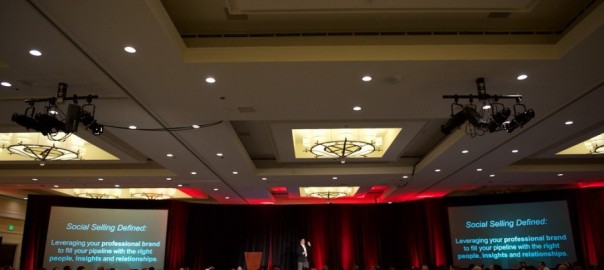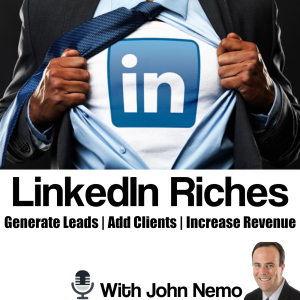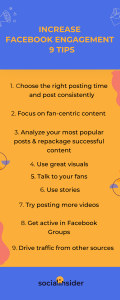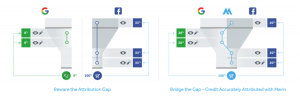
Several months ago I had the opportunity of being on my second Salesforce Live broadcast “Using social connections to turn prospects into customers“. Truely an awesome experience. It’s the closest thing to being on TV in my professional life. Over 30,000 people streamed the broadcast and the engagement on social media was amazing.
As I watched the recording of the show recently to listen back on some of the key points delivered I realized I had mentioned how I got started with social selling. I don’t usually talk about my past (I’m more of a forward thinker) but I got a few questions online like “how did you get started?” and “what made you think about social media for sales?”. Even one LinkedIn connection request that said “I had no idea you were in sales before, you’ve just been the social selling expert as long as I’ve followed you.”.
So other than what you can see on my LinkedIn profile, let me tell the story of how I started my journey into social selling.
It started with LinkedIn
I joined LinkedIn in May of 2005 and like most people at the time it was my online resume, my online identity to headhunters and hiring managers. I had just returned from serving a tour of duty in Iraq and was working as an inside sales rep for a small software company. I connected with coworkers and some of the people I got to know in the industry.
I didn’t do any “work” on LinkedIn, I was too busy being measured on number of dials and talk time. I like to refer to this as the Dark Ages of Sales. Outside of my sales numbers, weekly conversations about my dials and talk time were the norm. The problem was that even then, dialing for dollars was a colossal waste of time. My number wasn’t being made by these cold calls, it was being made because I was getting referred to new business by people I had already done business with.
Marketing’s contribution was very small, granted back then it could not have been measured as well as it can today but the old paradigm of marketing did little for my pipeline regardless. The calls and emails would go unanswered 90% of the time.
Instead of calling through the batch of new leads thrown over the fence from marketing, I started my day contacting the few people that had viewed my LinkedIn profile in the past 24hrs. Any guess what my ROI was on this? 100% every day. It was the Golden Age of social selling and I was reaping the benefits. After those were done, I would drone through the leads in the CRM.
Then I got introduced to LinkedIn groups.
I figured all I needed to do was to get more people to view my profile and then I could scale out this operation. Someone I worked with introduced me to a group in LinkedIn that had people talking about our industry. In-between cold calls I would go into a group and look at the profiles of the people having discussions, maybe answer a question or ask something of the community.
Over the course of the next couple weeks something magical happened. I noticed that the number of people viewing my profile was steadily increasing and my mornings of contacting these people was bleeding into my afternoons or consuming the entire day. I was hooked.
LinkedIn almost got me fired
My boss at the time didn’t share in my enthusiasm. My number of dials was way down and I mean it was the worst of the entire team. My talk time was alright but that didn’t matter, I had to “do my calls” or my job was at risk.
My pipeline was good, deals were coming in. I was consistently at or above 85% of my goals. When the end of the Quarter came around my boss wasn’t happy with me but I was closing deals so I stayed for a while. I was onto something new and a switch was flipped in my head. Social media was the next frontier for sales.
The dawn of social media
Social media was growing in popularity. The problem was that companies were very slow in adopting it or even understanding what it was.
I started tweeting and posting on other networks but when it came to business, LinkedIn was the place I lived. My typical process was to find people being active in other social networks and then connecting with them on LinkedIn. LinkedIn was the hub and all of the other sites were my spokes that fed the machine.
The “who’s viewed my profile” strategy was continuing to produce results. LinkedIn groups was not the only river to swim in. The more active I got on other social media channels, the more views I got on LinkedIn and the more people I could connect with.
The downside was that that I had lost focus. Many of the people I was connecting with were not people I would do business with, most were just other social media enthusiasts. I was becoming more popular with marketing professionals trying to understand “that social media thing” than I was with my customers or future customers. It was time to recalibrate.
The rise of social selling
I cover a lot of the important points in my other post The Rise of Social Selling. In order to recalibrate I narrowed my focus back to the basics, professionals that were talking about and interested in what I was selling. This didn’t mean that all I did was sell to them but I focused my engagement strategy on the decision makers in my industry. Understand that. It was an engagement strategy, not a sales strategy.The main difference was that I wasn’t as concerned about filling my pipeline with opportunities as I was in building social capital with the people who would eventually be looking for a solution to a problem.
As I built out that network something great happened. Well, two things happened. I started to become the resource of knowledge in the industry and these decision makers were coming to me to talk about trends and information. My online identitystarted to become more like a brand. I went from selling to helping. Which ultimately sold more through indirect means.
When you focus on adding value and showing benefits vs. getting the business and talking about features, people open up and the real discussions can take place.
The successful sales people I come across now say the same thing. Always be adding value, when the person sitting on the other end of the desk or phone sees more value than what the cost is, they typically buy. Be valuable.
(218)










